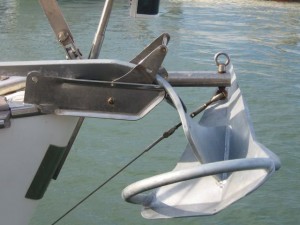Anchors are simple right, a hook you throw overboard that falls to the bottom and holds the boat in place because it is heavy.
WRONG!
In order to be effective anchors must dig into the bottom in order to hold a boat in place, weight alone isn’t enough. Additionally they must dig into various types of bottoms (mud, sand, rocky, shells, weeds, etc.), load direction changes from wind or waves and shock loads when the boat moves around the anchor. As I started to research what kind of anchor to buy I became aware that there are at least 20 different kinds of anchor each of which with its own strengths and weaknesses. Turns out anchor technology has been advancing at a relatively constant pace since early 1900s. In addition, a lot of anchors designed had excellent performance in the area where they were designed but failed when used in other areas.
Besides the type of anchor there is are continuous arguments about:
- how heavy an anchor should be versus size of boat,
- whether your rode (anchor rope) should use all chain or a mix of chain and rope to attach to the boat,
- what the length of the chain versus rope should be,
- how much total chain and/or rope to have on board and
- whether you should concentrate the weight in the chain or in the anchor.
A thread on the last point has over 1000 posts since the beginning of the year… how does one decide anything!
On type, thankfully in the last decade one style of anchors has been developed by a partial circumnavigator named Peter Smith who designed his own after becoming fed up with the current limits of the anchors he currently owned. Since the release of his anchor several other brands have appeared with very similar looking anchors which of course sparks  more debates on whether the original or the later designs are better. Independent of which designs is the best, the quality of manufacturing has varied depending on when and where the anchors were made. One manufacturer switched to Chinese production from Canadian production and soon had to replace a bunch of anchors because the Chinese steel bent under normal loads.
more debates on whether the original or the later designs are better. Independent of which designs is the best, the quality of manufacturing has varied depending on when and where the anchors were made. One manufacturer switched to Chinese production from Canadian production and soon had to replace a bunch of anchors because the Chinese steel bent under normal loads.
Enter Richard: He has about $1000 to spend on one anchor and rode as the boat he boat currently has two anchors of an old design and he wants to have confidence that the boat will stay put when he leaves it. Most manufacturers suggest between 45lb to 65lb anchor for his boat for normal use. But he is going to the Caribbean where he might need to use his anchor as a storm anchor which should be heavier. Anchors are expensive, when you get into the 50lbs range with a galvanized anchor costing about $500. For a shiny stainless steel anchor the price could be $2500 or higher! The heavier storm anchor will cost at least $700 before shipping… should he compromise on size for cost or bite the bullet?
Then google saves the day with its automated shop feature! Google scoured the net and found that Walmart (!) is selling his storm anchor for 15% lower than the msrp and will ship it free to the US. So he bought it after the calling the manufacturer and finding out that the price reduction and the free shipping was a glitch.
All I need now is a rode (anchor rope) for the boat but I am not sure what the size of the gypsy (electric chain puller) is on my boat so that might have to wait until I get to Tampa.



Sooo….what happened with the anchor??
The anchor is on the way to the boat yard. Next week I will hoist it onto the bow roller. I hope it fits
Thanks for the card and update letter, we wish you all blessed Christmas and happy and safe sailing in the new year. The Vandersleens